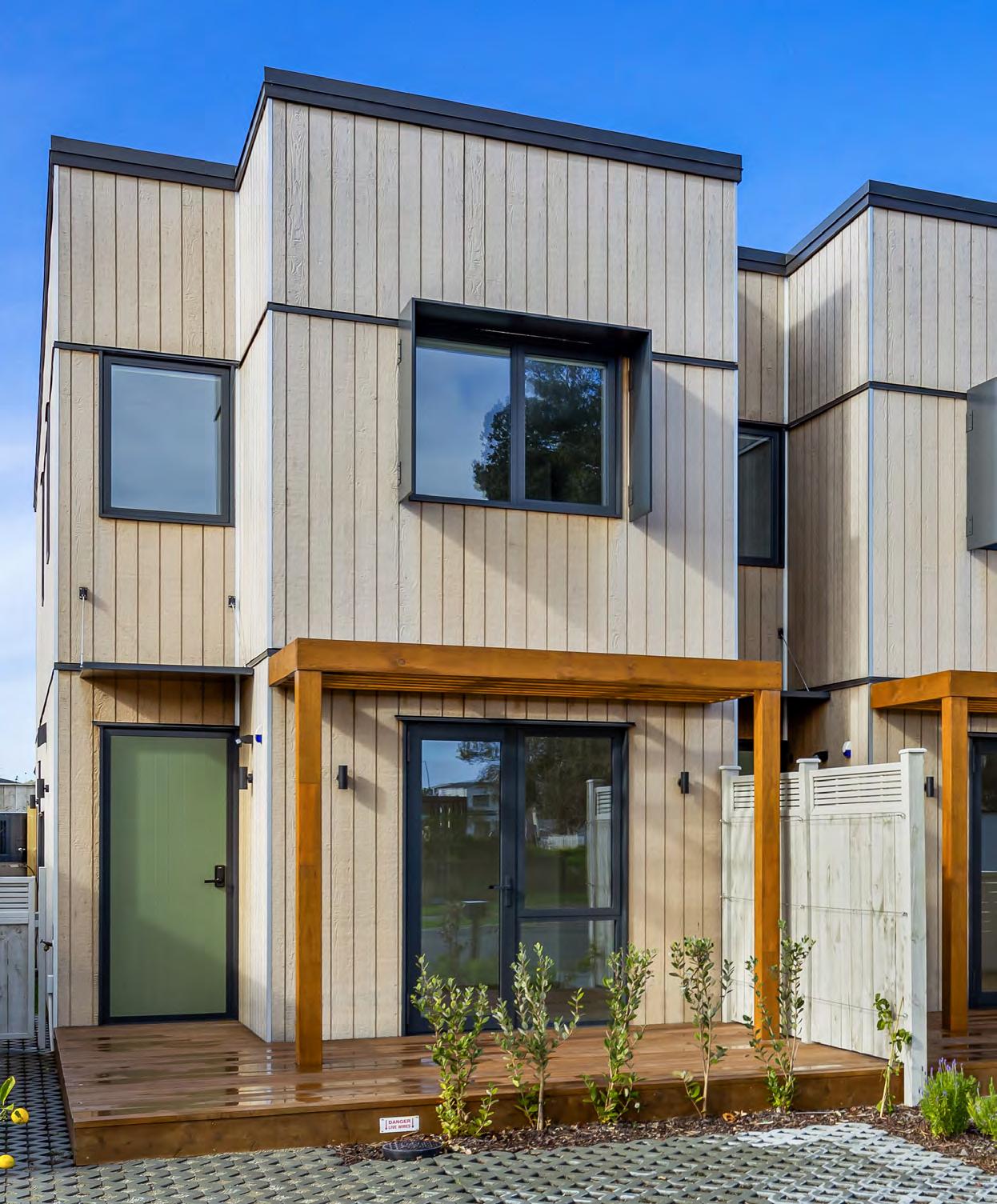NZ INSTALLATION MANUAL
WEATHERGROOVE PANELS

513 (2020) 514 (2020)


513 (2020) 514 (2020)
Family owned and manufactured in the Hunter region, NSW since 1939.
Low VOC. Meets New Zealand Building Standards. 100% natural product. BRANZ appraised. No added silica, resins or formaldehydes.

Weathertex is part of the Declare Label Program by the Living Future Institute Australia. This recognition highlights our commitment to product transparency and sustainability.
Better than zero carbon footprint with Third Party CredentialsGreenTag certification, PHD, PEFC. Low embodied energy.
DURABLE
Termite Resistant. Warranty tried and tested not to rot, split or crack for up to 25 years. Natural range is the only timber product in the market to provide a 15 year warranty.
1000 kg/m3 product density with a minimum 32MPa rating.
A wide selection of profiles available in various styles, textures and sizes. Easy to incorporate the natural with primed profiles together to offer multiple design options. Curved walls can be achieved down to a minimum of 2.5m radius for Selflok and 7m for Weathergroove.
No special tools required for cutting. Large panels and lower wastage costs on Weathergroove Range. Lightweight product - reduces labour costs.
Larger panels for quick installation. 9.5mm thickness and matching accessories across all products making it easier to mix multiple profiles within a project. Easier to paint than other materials on the market due to its smoother surface.
513 (2020) 514 (2020)
NATURAL RANGE IS PLATINUM GREENTAG CERTIFIED.
PRIMED RANGE IS GOLD GREENTAG CERTIFIED.
THE FIRST MANUFACTURED PRODUCT GLOBALLY TO ACHIEVE PLATINUM GREENTAG™ CERTIFICATION
Weathertex products and installation methods have been comprehensively evaluated and deemed fit for purpose and Building Code Compliant in New Zealand.
Weathertex products are covered under four BRANZ Appraisals:
• 513 Weathertex Direct Fixed Weathergroove Panel Cladding Systems
• 514 Weathertex Cavity Fixed Weathergroove Panel Cladding Systems
Weathertex has been assessed by an Accredited Testing Laboratory to AS 1530.4, that the attachment of Weathertex 9.5mm cladding systems detailed in Table 1.1.2 over plasterboard timber and steel plasterboard lined walls that has been either tested or assessed to meet NZBC Acceptable Solutions C/AS1 and C/AS2 and NZBC Verification Method C/VM1, would not detrimentally affect the FRR of the underlying wall system.
Weathertex can be used over systems such as the GIB FRR plasterboard systems. Contact the system manufacturer for further advice. AS 1530.4 report available on request.
WEATHERTEX WEATHERBOARDS AND ARCHITECTURAL PANELS.
Weathertex weatherboards and architectural panels have been comprehensively tested to New Zealand and International Standards for verification of compliance to the New Zealand Building Code.
MATERIAL DURABILITY PROPERTIES
The Product Specification Standard for Weathertex is AS/NZS1859.4 - Wet Processed Fibreboard for Exterior Conditions (HB.E).
THERMAL AND ACOUSTIC PROPERTIES
Thermal Conductivity 0.22 W/mK
Thermal Resistance 0.04 m2K/W
Acoustic Properties (Rw) System Dependant
• Suitable with SH Risk Group classification
Where thermal and acoustically rated walls are required: Weathertex can be used as part of wall systems to meet your specific performance requirements.
• Suitable with building height of <= 10m and >= 1m to relevant boundry.
• Refer to NZBC Acceptable Solutions C/AS1 and C/AS2 Paragraph 5.8.1 for the specific exterior surface finishes requirements for other building risk groups.
PREVENTION OF FIRE
• Separation or protection must be provided to the Weathertex Sheet and Architectural Panel Cavity system from heat sources such as fire places, heating appliances, flues and chimneys
• Part 7 of NZBC Acceptable solutions C/AS1 and C/AS2 and NZBC Verification method C/VM1 provide methods for separation and protection of combustible materials from heat sources.
FIRE PROPERTIES
Average Specific Extinction Area AS/NZS 3837 38.7 m2/kg Material Group Number AS/NZS 5637.1 Group 3
Fire Resistance Rating (FRR)
MISCELLANEOUS PROPERTIES
and 90/90/90 Systems Available
Weathertex contains no silica, resins, binders or added formaldehydes and the results above confirm the amount naturally present in hardwood timber is negligible and well below the acceptance level of 1.0mg/L (E1).
The manufacturer’s installation requirements are in addition to local and national codes and regulations. Weathertex provides a suite of Construction Details, available for download on the Weathertex Website which should be used in conjunction with this manual. Note: All diagrams in this installation manual are for demonstration purposes and diagrams may omit some components for clarity.
Deviation from standard applications and requirements detailed in this Installation Manual and supplementary Weathertex Construction Details will void the manufacturer’s product warranty.
The product specific installation instructions in this manual are applicable to steel and timber frames for both direct fix and cavity systems. Preparation steps must be followed for direct fix to timber frame, ventilated cavity construction and steel frame construction and are given in the Frame Preparation Section.
Weathertex timber products must be stored flat, under cover and on timber bearers spaced at maximum 600mm centres. When storing Weathertex outside, keep the stack minimum 100mm clear of the ground and cover with waterproof materials to prevent water staining. Note: Weathertex factory stretch wrap is not designed to keep stored product weatherproof and should not be relied upon for primary weather protection.
Anodised aluminium products should be stored in a dry and flat position away from any potentially corrosive or incompatible materials. Timber or soft bearers at a distance no more than one metre apart should be used to support the product. Continuous exposure to moisture will promote corrosion. Metal edges and cut corners can be sharp and may cause personal injury if not handled safely. Wear eye protection and gloves to protect skin and when cutting to avoid airborne metal fragments.
1.3.2
Weathertex products are easy to cut and shape with a normal hand or power saw. Weathertex may be stacked two or three high for multiple cutting. Where required, edges may be trimmed with a smoothing plane or sandpaper. Holes are easily drilled with high speed drills or clean cutter bits.
Standard health and safety precautions should be taken when working with timber products. Machine tools should be fitted with dust extractors and work areas kept clean and adequately ventilated. If dust levels exceed New Zealand safe work standards, the wearing of a dust mask (AS/NZS 1715 and AS/NZS 1716) and safety glasses (AS/NZS 1337) is recommended. A Safety Data Sheet is available for download on the Weathertex Website.
1.3.3
The site on which the building is situated must comply with NZBC Acceptable Solution E1/AS1 - Surface Water. Foundation design must comply with requirements of NZS 3604 for timber frames building or NASH Standard Part for light steel framed building or must be to a specific engineering design. The grade of adjacent finished ground must slope away from the building to avoid the possibility of water accumulating.
Timber framing must comply with NZS 3604. Buildings or parts of buildings outside the scope limitations of NZS 3604 must be to a specific design in accordance with NZS 3603 and AS/NZS 1170. Where specific design is required, framing must be of at least equivalent stiffness to the framing provisions of NZS 3604. All framing sizes and layout must comply with NZS 3604 in addition to maximum stud and dwang/nogging centres required by the Weathertex Installation Manual.
The floor level must have a minimum clearance to paved or unprotected ground as required by NZBC Acceptable Solution E2/ AS1 or E2/AS4 (NASH Building Envelope Solutions 2019). Weathertex Architectural Panels must overhang the bottom plate on a concrete slab and timber frame floors by 50mm. The bottom edge of Architectural Panels must be kept clear of paved surfaces by a minimum of 100mm and a minimum of 175mm above unprotected ground (i.e. grass, gardens, etc).
Weathertex Architectural Panels are intended for use as internal and external cladding in standard stud wall systems. It is the responsibility of the Designer or Specifier to identify moisture related risks associated with any particular building design.
Wall construction design must effectively manage moisture, considering both the interior and exterior environments of the building, particularly in buildings that have a high risk of wind driven rain or are artificially heated or cooled. Adequate design of ventilation, flashings and moisture management systems must ensure that the wall cavity and the back of the Weathertex board will remain dry at all times.
Walls shall include provisions as required by the NZBC Acceptable Solution E2/AS1 - External Moisture. In addition, all wall openings, penetrations, junctions, vertical and horizontal joins, connections, window heads, sills and jambs or other components, must incorporate compliant flashing for weatherproofing.
Flashing must have a minimum 15 degree fall away from the cladding, and the Weathertex must be installed with a minimum 10mm gap between the Weathertex and the flashing. Weathertex, under no circumstances permits the installation of the drip edge into end stops or other U-channels
Weathertex Architectural Panel systems have been appraised by BRANZ for weathertightness on timber or steel framed walls situated in NZS 3604 Wind Zones up to and including Extra High. The choice of system should be appropriate to the risk score calculated in accordance with NZBC Acceptable Solution E2/AS1 Table 2:
Additional Construction Details are available on the Weathertex Website.
Vapour Permeable Building Wrap must be used under all Weathertex external wall systems. The vapour permeable wrap allows for the controlled escape of vapour from within the building whilst restricting the ingress of liquid moisture. Compliant building wrap must be installed in accordance with NZBC Acceptable Solution E2/AS1, and the wrap manufacturer’s installation instructions.
The permeability and vapour resistance of materials should be considered in the context of their application. The designer/architect/ engineer should consider strategies to mitigate condensation risks in the design with relevance to local climate conditions. Suitable products for moisture control in hot wet and humid conditions should be discussed with the building wrap manufacturer.
Soft compressible insulation installed directly between the front of the wall studs and Weathertex cladding is not compatible with Weathertex products and will void the product warranty.
Material Standard NZS 2295
Installation Standard E2/AS1
Mandatory Properties (as per AS/NZS 4200.1)
Vapour Resistance ≤ 7MNs/g (Class 3 or 4)
Water Barrier HIGH
PRIMER:
Weathertex factory primer is designed to be painted within 60 days of installation. Failure to do so can result in poor topcoat adhesion and will void warranty. Lightly sand any nibs or blemishes which have occurred during fixing. Sawn edges, holes and countersinks must be re-primed with high quality tannin blocking exterior primer (water or solvent based). A spray primer is the most efficient method. It is also good practice to prime any timber mouldings, including corner stops and trims.
Trimtec aluminium accessories are protected by an anodised coating and can be left unpainted if desired. Due to their smooth surface, aluminium accessories should be etch primed if a topcoat is to be applied.
Once boards are installed, clean all surfaces with a mild sugar soap solution using soft broom or lint free cloth to remove salt, dirt, dust, oils, grease and other airborne contaminates. Isopropyl alcohol and a cloth may also be used to remove stubborn oil, grease or waxy contaminants.
Do not vigorously scrub the surface nor use corrosive cleaners as this may burnish the paint surface and mark the primer finish. Wash down with fresh water and allow to completely dry. Not allowing the board to dry before painting is a common cause of paint failure. Failure to properly prepare the surface may result in poor adhesion with topcoat and may void the paint manufacturer’s warranty. Never use high pressure washers as this can cause coating damage and water ingress into the wall cavity.
The primed surfaces of Weathertex products are suitable for the application of exterior grade water or solvent based topcoat paint systems. It is recommended to apply selected coating to a test area to confirm suitability. If compatibility of the selected topcoat is an issue, the surface may be primed with a suitable tannin blocking exterior primer per the coating manufacturer’s recommendation before painting. Contact the paint manufacturer for advice or information.
When top coating, apply a minimum of two coats of paint in accordance with the paint manufacturer instructions for mixing, film build, coverage and drying between coats. Temperature, coating thickness and humid conditions will affect curing of coatings and consideration of site conditions at the time of painting is essential to ensure proper curing, adhesion & to avoid surfactant leaching. Incorrect curing conditions will void the manufacturers warranty. Paint additives may adversely affect the coating adhesion and durability and should only be used with the endorsement of the coating manufacturer.
Weathertex hardboard products have 50 years proven durability in the harshest of climate zones. While there is a vast array of colours to paint your home, it is important to understand the effect paint colours can have on the performance of construction products. As Weathertex is a timber product, its dimensions will expand and contract with changes in moisture content. Dark paint colours can allow surfaces in warmer climates to become very hot in direct sunlight leading to loss of moisture and subsequent shrinkage of the weatherboard.
Selection of light paint colours with high Light Reflectance Values (LRV) will lead to better thermal efficiency of the building, improve the maintenance cycles of paint coatings and sealants while minimising the thermal expansion and contraction of all construction components. With darker paint colours we recommend pre-painting the ends of the weatherboard prior to installation of joining/corner accessories. Screw with filler can be used with dark colours, however due to the additional movement of construction components with dark paint colours, filler may be prone to moving and becoming visible. Weathertex recommends nail fixing with dark paint colours.
Darker paint colours require a longer curing time in ideal temperature & humidity. Temperature, coating thickness and humid conditions have an increased effect on the curing of darker paint coatings. Consideration of site conditions at the time of painting is essential to ensure proper curing, adhesion & to avoid surfactant leaching. Incorrect curing conditions will void the manufacturers warranty.
Weathertex Natural Range are uncoated hardwood timber products that will fade to a rustic grey with UV exposure just like raw timber. Manufactured with a mixture of native Australian eucalypt species, the original colour and greying process can vary due to the seasonal variation of harvesting areas. Weathertex Natural may be left raw to grey off over time, or be coated with a quality decking stain to maintain the rich appearance of new timber.
NOTES:
1. Painting natural board with a standard top coat (paint) finish or a clear coat will void the manufacturer’s warranty. If a top coat finish is to be applied, it must be onto Weathertex’s pre-primed board.
2. Varnishes and clear coats are not suitable for external applications of Weathertex products. They do not provide adequate UV protection, their inflexibility can result in cracking/crazing and can cause irregular surface aesthetics. It is the customer’s responsibility to confirm coating suitability from the coating manufacturer.
SURFACE PREPARATION - CLEANING & WASHING:
After installation, prepare the surface by removing dust and contaminants with an Oxalic Acid timber cleaner solution. A soft broom or cloth may be used to gently scrub all surfaces. Wash down with fresh water and allow to completely dry. Not allowing the board to dry before coating is a common cause of coating failure. Failure to properly prepare the surface may result in poor adhesion and may void the coating manufacturer’s warranty. Never use high pressure washers as this can cause coating damage and water ingress into the wall cavity.
Apply 2-3 coats minimum of a recommended semi transparent water based stain or approved oil stain (WOCA) in accordance with the coating manufacture’s application instructions. It is best to brush apply coatings to ensure proper penetration into the woodgrain timber featured surface. Cutting in should be performed after the first coat is applied to avoid a dry-line boarder in the finish.
Weathertex Natural may also be left to lighten before staining for different colour results. Coating providers offer a wide range of colours that may be used and a test sample should always be performed to confirm colour expectations and performance before coating.
Left to weather naturally by the sun, the uncoated timber will lighten and “grey off” over time similar to raw hardwood. The degree and speed of colour change will depend on the intensity of UV exposure. The design of the installation must allow for consistency of sun exposure as shade lines caused by other features will result in colour variation and inconsistent weathering patterns.
When allowed to weather naturally some small black spots on the surface may become more visible. This is carbon which is inherent within raw timber and the manufacturing process. These small black spots are not mould and will not affect the performance or longevity of the product.
Note: Natural Products are composed of unsealed natural hardwood timber which may occasionally exhibit tannin bleeding. Consideration must be taken if installing unsealed Weathertex products above porous or light coloured features.

The extent and nature of maintenance will depend on the geographical location and exposure of the installation. Regularly wash the painted surface with mild soapy water to remove dirt and grime to improve the performance of the coating. Never use high pressure washers as this can cause coating damage and water ingress into the wall cavity.
Thoroughly inspect topcoat paint work at the end of year 1 and repair areas of damage/coating breakdown according to the original paint specification or approved equivalent. Repeat inspection process at year 5 and based on the results of this condition survey make a decision on future maintenance actions, which may include touch up/repair of areas or a full recoat.
Additional basic maintenance tasks include but are not limited to controlling vegetation and garden beds close to the installation, keeping gutters and pipes clear, addressing potential moisture damage due to overflows and replacement of penetrations, flashings and sealants used in installation as required. Generally, exterior surface coatings deteriorate by chalking rather than flaking. When repainting becomes necessary and the surface is unbroken, remove loose chalk by lightly sanding and follow the preparation steps above. Reapply new coatings in accordance with the paint manufacturer’s instructions.
The extent and nature of maintenance will depend on the geographical location and exposure of the installation. Weathertex may be periodically cleaned with mild soapy water or a suitable timber cleaner. Never use high pressure washers as this can cause coating damage and water ingress into the wall cavity. Additional basic maintenance tasks include but are not limited to controlling vegetation and garden beds close to the installation, keeping gutters and pipes clear, addressing potential moisture damage due to overflows and replacement of penetrations, flashings and sealants used in installation as required.
Thoroughly inspect any coatings at the end of year 1 and repair areas of damage/coating breakdown. Repeat inspection process at year 3 and based on the results of this condition survey make a decision on future maintenance actions, which may include touch up/repair of areas or a full single coat.
Generally, semi-transparent stains are softer and less UV resistant than regular exterior paint meaning resulting in a 3 - 5 year recoating cycle. When recoating becomes necessary follow the preparation and coating steps above. A darker/more opaque stain colour may be required in time to maintain the desired colour of the boards.




Failure to follow any of the above preparation instructions may void warranty of the product.
NOTE: Rate of fading may vary from above photos depending on environmental factors.
75
150
300
600
1,200
1.7.1 NOTES
1. Radius to internal surface of the Weathertex panel.
2. Studs spaced at a maximum 300mm centre around curve, for all models, surface finishes & wall radii.
3. Double stud at the vertical edge when joining panels.
4. Space fixings at 150mm at panel edges, 300mm through centre of panel.
5. Refer to Installation Manual for additional information and instructions.
• Use a Countersink drill bit to pre-drill and countersink each fastener location, ensuring fasteners are fixed 2mm below the surface. Space fasteners 150mm along edges and 300mm through body of panel.
• Use a Treated Pine Countersunk Head 10g Screw or equivalent for SG8 timber framing studs.
• See 2.3.4 for instruction on filling countersink screw holes.
• Commence fixing either at vertical edge or at the centre line of panel.
• Progressively fix at each stud to complete the curve.
• To connect panels use a suitable length of Weathergroove Joiner.
• Slide the Weathergroove Joiner onto the rebated vertical joining edge and fasten off through the exposed back flange of the joiner with a flat head nail or screw.
























































































































































































































Frames must be straight and true. Studs must be at a maximum 600mm centres - see product specific structural wind loading for system details. Internal corners may require additional stud work - refer to Weathertex Construction Details. Dwangs/ Noggings must be provided at maximum 800mm centres for Weathergroove Panel Installation. Check for additional product specific framing requirements including Weathergroove horizontal batten installation 2.4.7.
• Building wrap must be installed in accordance with E2/AS1 and the manufacturer’s installation instructions building wrap.
• For cavity installations building wrap must be installed in between the frame and cavity battens/thermal break battens.
• Building wrap must have a minimum overlap of 100mm at horizontal joins and 150mm at vertical joins and corner junctions.
• Weathertex must be separated from concrete/masonry. Where separation is required, then a damp proof course (DPC) must be used.
• Building wrap must be tightly secured to prevent bulging of bulk insulation from impinging on the ventilated drainage cavity in accordance with NZBC E2/AS1 paragraph 9.1.8.5.
• Flexible flashing tape required to be installed around windows and penetrations see below example.
All windows and penetrations must be appropriately flashed in accordance with E2/AS1 before cladding is installed. Head flashings are required to be installed to ensure any water is draining away from the window and is not draining into the wall. Head flashings will change based on the selected window, the use of a cavity etc. Below is where window flashing tape is required and typical head flashing used for window installation. See Weathertex Construction Details available on the Weathertex website for further details.

Flexible Flashing Tape
See E2/AS1 for further requirements
Flashing Wall Wrap Weathertex Cladding Board Clearance 10mm to flashing *Direct fix example shown

Trimtec Aluminium Corner Accessories are installed over the cavity battens and before Weathertex Cladding is installed. Aluminium is subject to thermal expansion/contraction and it is recommended that 1mm expansion gaps be used.
• To stop vermin entering the cavity, a Weathertex Large/custom Cavity Closer must first be fitted to the base of the wall and above window head flashings.
• Cavity battens must be installed vertically on all studs and will overlap into the cavity closer.
• Castellated cavity battens or cavity spacers must be installed horizontally on all dwangs/noggings and top/bottom plates when installing Weathergroove Products.
• Cavity battens must be installed as to not obstruct the drainage plane or openings in the cavity closer.
• NZBC Acceptable Solution E2/AS4 (NASH Building Envelope Solutions) 1.1.2 requires a thermal break batten to be installed between light weight external cladding and steel frames to prevent thermal bridging and subsequent loss of energy efficiency of the wall system.
• To stop vermin entering the cavity, a Weathertex Large/custom Cavity Closer must first be fitted to the base of the wall and above window flashings.
• Thermal break battens must be installed vertically on all studs and will overlap into the cavity closer.
• Thermal break battens must be installed horizontally on all dwangs/noggings and top/bottom plates when installing ventilated thermal break batten Weathergroove Products.
• Cavity battens must be installed as to not obstruct the drainage plane or openings in the cavity closer.
To ensure a free draining cavity when installing horizontal cavity battens on to the noggins/dwangs when installing Weathergroove or Trimtec Long Vertical joiners there are 3 options available as shown below (building wrap omitted for clarity).
• Cavity spacer—installed on a 5° angle with 50mm gap between the spacer and vertical battens. Batten to be temporarily tacked into place as the final board fastening will secure it.
• Bevelled double castellated cavity batten sloping towards the cladding
• Ventilated cavity battens— Thermally rated battens to be used on steel Frames
*Sarking and fasteners omitted for clarity
Cavity spacer installed on a minimum 5° angle with a 50mm gap between stud batten and spacer
Weathergroove is the ideal choice for urban contemporary projects. It’s the tallest panel available in the New Zealand market, making this vertically grooved panel ideal for covering large areas in a short time and it’s versatility offers endless possibilities.
Features & Benefits
• Off stud joining option enables minimal waste and less timber stud layout.
• Quick cost effective installation.
• Weathertight mechanical joining system available.
• Range of joining systems for various design options.
• Universal edge which makes it possible to flip and reuse offcuts.
• Durable with 25 years warranty (pre-primed) and 15 years warranty (Natural).
Thickness: All panels are 9.5mm thick Width: All panels are 1196mm wide

WEATHERGROOVE 75 SMOOTH
3660mm x 1196mm Code: 108400

WEATHERGROOVE 300 WOODSMAN
3660mm x 1196mm Code: 500082

WEATHERGROOVE 75 NATURAL
3660mm x 1196mm Code: 108450

WEATHERGROOVE 75 WOODSMAN
3660mm x 1196mm Code: 108410
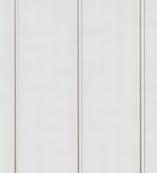
WEATHERGROOVE 150 SMOOTH
3660mm x 1196mm
Code: 500030
3050mm x 1196mm
Code: 500031
2745mm x 1196mm Code: 500032

WEATHERGROOVE 600 SMOOTH
3660mm x 1196mm Code: 500230

WEATHERGROOVE 1200 SMOOTH
3660mm x 1196mm Code: 500330
2745mm x 1196mm Code: 500332


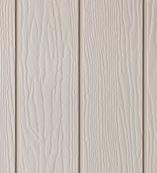
WEATHERGROOVE 150 RUFF-SAWN
3660mm x 1196mm Code: 500025
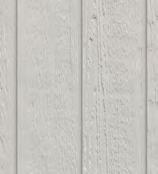
WEATHERGROOVE 150 WOODSMAN
3660mm x 1196mm
Code: 500066
3050mm x 1196mm Code: 500067
2745mm x 1196mm Code: 500068

WEATHERGROOVE 1200 WOODSMAN
3660mm x 1196mm Code: 500370


WEATHERGROOVE 300 SMOOTH
3660mm x 1196mm
Code: 500130
2745mm x 1196mm
Code: 500132
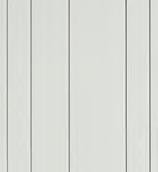
WEATHERGROOVE FUSION SMOOTH
3660mm x 1196mm Code: 500340

WEATHERGROOVE FUSION WOODSMAN
3660mm x 1196mm Code: 500350

3660mm x 1196mm Code: 500078
3660mm x 1196mm Code: 500074 WEATHERGROOVE
WEATHERGROOVE 1200 NATURAL
3660mm x 1196mm Code: 500380
WEATHERGROOVE FUSION NATURAL
3660mm x 1196mm Code: 500360
*Made from anodised aluminium
SMALL INTERNAL LF CORNER (code: 149555)
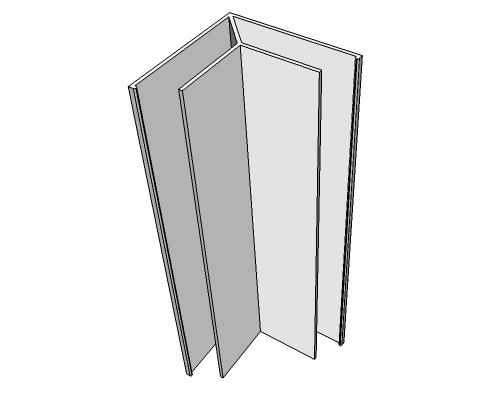
SMALL EXTERNAL LF CORNER (code: 149755)

SMALL END STOP (code: 150155)
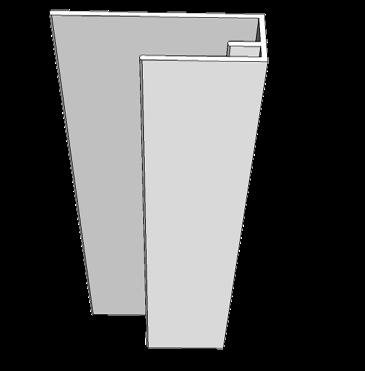
SMALL INTERNAL CORNER (code: 149500)

SMALL EXTERNAL CORNER (code: 149700)

WEATHERGROOVE JOINER
(3660 code: 146850) (3050 code: 146845) (2745 code: 146840)

L = 3660mm
a = 27mm
b = 11mm
c = 55mm
L = 3660mm
a = 27mm
b = 11mm
c = 31mm
L = 3660mm
a = 27mm
b = 11mm
c = 45mm
L = 3660mm
a = 4mm
b = 11mm
c = 35mm
L = 3660mm
a = 17mm
b = 11mm
c = 35mm
L = 3660,3050, 2745mm
a = 12mm
b = 5mm
c = 50mm
*Made from anodised aluminium PRODUCT
SMALL Z FLASHING (code: 149960)
For general horizontal joins

Z FLASHING (code: 149900)
An alternative for general horizontal joins

SMALL CORNER PLUG (code: 149750)

INTERNAL COMBO CORNER
a= Primelok
b= Weathergroove/Selflok (code: 146900)

EXTERNAL COMBO CORNER
b= Primelok
c= Weathergroove/Selflok (code: 146950)

2.2.3 CAVITY WALL SYSTEM
CAVITY CLOSER
L = 3000mm
a = 20mm or 30mm
b = 50mm
L = 3670mm
a = 10mm
b = 10mm
c = 74mm
L = 3660mm
a = 27mm b = 10mm
Use with the Small external corner *made from PVC
L = 3660mm
a = 20.9mm
b = 10.7mm
c = 58.3mm
d = 48.3mm
e = 4mm
L = 3660mm
a = 27.3mm
b = 20.9mm
c = 10.7mm
d = 35mm
e = 45mm

The table below displays the maximum allowable wind zone according to frame type, fasteners and fastening pattern used to install Weathertex Weathergroove Panels. Maximum wind zone classifications have been evaluated for lined walls (Cp,i = 0) within 1200mm of the building corner using ultimate limit state design pressures in accordance with AS/NZS 1170 and NZS 3604. Ultimate limit state design pressures may also be used for Specific Design (SD) wind zones.
Installers must assure themselves that the appearance of the selected fastener is suitable for the intended use. Generally, head sizes in excess of 6mm or T and D head shaped nails may not produce a satisfactory finish on face fixed profiles.
• Stainless Steel ND Brad Nails recommended for ruff-sawn, woodsman & natural profiles. They are not permitted for smooth profiles as they may create an undesirable surface finish.
• 2.5mm Ring shank nails recommended for smooth profiles.
• For countersunk screw method of Weathergroove Smooth profiles refer to 2.3.4
Flat Head Ring Shank Nail
Countersunk Head 10g Screw
Countersunk 2mm & filled
JoltFast Nail Paslode
2.87x65mm B20680
Refer to section 4.4.6 for sheet edge fasteners
0.75mm
Frame
10g x 50mm Minimum Countersunk Coarse Thread metal Screw Countersunk 2mm and filled see 2.3.4
* This wind table does not account for any additonal packing including RAB | Refer to
FASTENER NOTES: (notes apply to tables: 2.3.1 - 2.3.2):
1. Fasteners must meet the minimum durability requirements of the NZBC. All fasteners must be suitably coated to resist corrosion in external application. When installed in high corrosion zones, fastener material must be selected to meet the appropriate design life of the system and geographical location.
2. Minimum fastener dimensions are specified in the fixing table. Fastener length must be increased by the thickness or additional thickness of any packing or battens to ensure the same penetration into the structural subframe.
3. Nails must be finished flush to the board surface and not be punched and filled. Punching will significantly reduce the holding capacity of the fastener and damage the integrity of the board surface.
4. It is the responsibility of the designer/builder that the finished appearance of the selected fastener is suitable for the intended application.
5. Fastener length for steel frames must be of suitable length to allow three threads penetration through the steel and allow for packing and thermal break battens.
6. For Natural Board fasteners must be stainless steel, or Class 4 if screws.
Screw countersunk 2mm and filled
2.3.4
(Recommended for Smooth Profiles only)
When countersinking screws, these must be pre-drilled countersunk 2mm below the board surface and filled with a high quality proprietary grade, flexible paintable filler.
When using a smart-bit style countersinking tool; the gauge of the screw must match the gauge of the tool to prevent movement issues. Screw holes should be spray primed after screwing with a solvent or water based primer and given adequate time to dry. Filler should be sanded and area re-primed prior to painting with a solvent or water based primer.
Weathertex recommends nail fixing when painting with dark paint colours (LRV 40% and lower) as dark colours lead to additional movement of construction components where filler may be prone to moving and becoming visible.
Failure of the product to hold its adhesive bond, is due to its inability to key to a surface. It is the responsibility of the builder/ installer to ensure that there is a good surface to bond to and the filler meets aesthetic expectations. Weathertex recommends a test area to confirm suitability.
*Refer to the Weathertex website for filler specifications, & please confirm with the filler manufacturer that the chosen filler is compatible with your specific project. **Non-flexible single pot & epoxy based fillers are not suitable and may crack and fail with movement of construction components.

The following product specific installation instructions are applicable for both direct fix (timber frame) and cavity fix (timber and steel frame). Installation instructions in this section are to be used in conjunction with information and requirements given in previous sections and all national building codes. Stud spacing to be selected by the building designer using the wind tables based on the wind classification to a maximum of 600mm. Sheet installed width nominally 1200mm.
Stud frame to be supported by flush noggings/dwangs at maximum 800mm centres where an off stud will occur. Check and straighten sub-structures as required.
Plan panel layout so off-stud joints occur approximately mid span between studs. The first panel may need to be a part panel.
If you are using horizontal joints you will need to ensure it is supported by a double or rotated noggings/dwangs or timber floor joist please see Z Flashing details for additional frame requirements based on your choice of accessory.
Framing must be planned so all vertical joints occur on double studs or a rotated 90mm timber back block with cavity battens for cavity fix centred on the join.
Check and straighten sub-structures as required.
If you are using horizontal joints you will need to ensure it is supported by a double or rotated nogging or timber floor joist please see z flashing details for additional frame requirements based on your choice of accessory.
1. Establish a horizontal datum or base line 50 - 60mm below the base of the frame.
2. Install damp course for separation between Weathertex and masonry.
3. Install corners to the frame (note: wall wrap must be installed first).
Building wrap (Refer 1.3.6, 1.8.2
Building wrap requirements & installation)
Cavity System (Optional)
Datum
Ground clearance (Refer to general requirements section 1.3.4)
1. Inset the panel edge into the corner accessory, align the bottom edge with the datum and use a single fastener at a corner to temporarily hold the panel.
2. Adjust the panel so that the panel grooves are vertical before fixing off temporarily with a fastener at the opposite corner.
3. Slide the Weathergroove Joiner onto the rebated vertical joining edge and fasten off through the exposed back flange at the centre nogging with a flat head or screw (this will stop the joiner slipping after installation).
4. Install successive panels in the same way using the Weathergroove Joiner.
NOTES:
• Can be used on and off stud with all products.
• Do not fix through the panel into the Aluminium Weathergroove Joiner.
• It is advisable to prepaint panel sides when using Weathergroove Joiners to avoid white lines either side of the Accessory after possible contraction of construction components in dry conditions.
Weathergroove joiner (off stud)

1. Install 100mm wide UV resistant flashing over the wall wrap at each planned vertical joint.
2. Before installing the first panel, run a 5mm bead of suitable, flexible sealant along the length of the UV resistant flashing to seal the edge of the Weathergroove panel.
3. It is standard to start at a corner with a cut panel to ensure the first joint is located on the planned double stud supports. Insert the cut edge into the corner accessory, align the bottom edge with the datum and use a single fastener at a corner to temporarily hold the panel.
4. Adjust the panel so that the grooves are vertically level before fixing off temporarily with a fastener at the opposite corner.
5. Weathergroove has a unique rebated edge that forms a regular groove when installed with an appropriate control gap. When joining panels, leave a 2mm gap in between panels to maintain the standard spacing of the grooves. Before installing the next panel, run a 5mm bead of suitable, flexible sealant along the length of the UV resistant flashing to seal both edges of the Weathergroove panel.
NOTES:
• Natural products are composed of unsealed natural hardwood timber which may occasionally exhibit tannin bleeding. Consideration must be taken if installing unsealed Weathertex products above porous or light coloured features.
• Natural only - butt join not permitted with pre-primed.
Suitable sealant
Building wrap (Refer to Building wrap requirements section 1.3.6)
Stainless steel fasteners or class 4 screws.
(Refer to 2.3 Fastening)
Suitable sealant

2mm gap
Horizontal joins must be flashed using the Small Aluminium Z Flashing, refer to the Accessories Section.
All horizontal joins must be supported by a double or rotated nogging. Install the accessory first before fastening off the top edge of panels.
When planning for a Z flashing on a wall, given the Flashing breaks the 2 sheets, it is determined to be a perimeter of the wall, the horizontal perimeter nail patten apply to both sheets meeting at the Z flashing.
The top panels should be installed such that the bottom of these panels rest on the spacer bead of the z flashing. Install successive panels in the same way using the Z-flashing for horizontal joints.
NOTE: For natural Weathergroove ensure the UV resistant flashing for the vertical join runs under the Z flashing.
For Inter storey junctions please see construction details.
2.4.6.1
Single rotated
Panels must be fastened at 150mm centres across the top and bottom of the panel and wall edge. All intermediate studs and noggings/dwangs must be fastened in accordance with the appropriate fixing pattern and fastener installation requirements in section 2.3. Intermediate panel edges should be fastened to the nogging either side of the joint. For Cavity Systems these fastening points at noggins need to be packed with a piece of cavity batten to support the joint.
NOTES:
• Perimeter fixings should be a minimum of 12mm from the panel edge.
• Fasteners must not be placed in the panel grooves.

Fasten at noggings either side of joint
Intermediate Fastening as per wind tables
150mm centre
fastenings (top and bottom of panel and wall edge)
Panels must be fastened at 150mm centres across the top and bottom of the panel and at studs along both vertical edges. All intermediate studs and noggings/ dwangs must be fastened in accordance with the appropriate fastener pattern and fastener installation requirements in section 2.3.
NOTE: Perimeter fastenings should be a minimum of 12mm from the panel edge and not be placed in the panel grooves.

Intermediate Fastening as per wind tables
Fasten at 150mm centres along vertical joints
150mm centre
fastenings (top and bottom of panel and wall edge)

2mm butt join (left open) back flashed
Weathergroove can be installed on horizontal battens as long as the following steps have been taken
1. Studs are at a maximum 600mm centres.
2. Noggins/Dwangs are installed at maximum 600mm centres—according to the wind table.
3. Follow the building wrap installation 1.3.6.
4. Install free draining cavity batten of choice castellated battens or Cavibat over the noggins/dwangs continuously along length of the wall. Install battens along the base of the wall allowing a gap between the cavity batten and the cavity closer.
5. Fasten Weathergroove panel at each batten (vertical battens (corners and penetrations) and horizontal battens at 150mm centres.
NOTES:
• Weathergroove joiner must be used for this installation method.
• Vertical members may be required around windows and penetrations.
Continuous cavity batten installed over noggins
600mm
600mm
Must use Weathergroove joiner
Vertical battens to be installed at corners, windows and penetration
Seamless look when complete
1. Weathertex Pty Ltd A.B.N 67 084 713 986 (“Weathertex”) warrants that the Products supplied are of first quality, free from material defect in materials, design and workmanship, and in conformity with the technical specifications detailed in the published Weathertex Installation Manual that is current at the date of purchase. This statutory warranty applies for a period of 12 months from the date of purchase in addition to the following clauses.
2. Natural Board - Weathertex warrants that its Natural (Brown) Board Products will not rot, split or crack for a period of 15 (fifteen) years from the date of purchase when installed and maintained in accordance with Weathertex’s current published materials.
Pre Primed Board - Weathertex warrants that its pre primed board Products (Selflok, Primelok & Weathergroove Primed Ranges) will not rot, split or crack for a period of 25 (twenty-five) years from the date of purchase when prepared, installed and maintained in accordance with Weathertex’s current published materials.
3. A reference to Products in these warranty terms and conditions does not include accessory products listed “Accessories” in the Weathertex Price List (“Accessory Products”). Weathertex warrants that the Accessory Products will be free from defect in material and workmanship for a period of 15 years from the date of purchase. For the purposes of clarity, the warranties provided in clause 1 and 2 do not apply to Accessory Products.
4. The benefits to the purchaser given by the warranties set out in clauses 1 to 3 are in addition to other rights and remedies of the purchaser under New Zealand Consumer Law in relation to the Weathertex products and accessories.
5. The warranties provided in clauses 1, 2 and 3 are only available to the original purchaser (“Purchaser”) who provides Weathertex with proof of purchase and who makes the claim in writing within 30 days from the point in time when the defect becomes apparent or should have become apparent.
6. Weathertex will not be liable for any warranty claims made under clauses 1, 2 and 3 if any of the following apply:
(a) the Products are not installed used or maintained in accordance with applicable instructions and/or specifications, including installation and site conditions provided by Weathertex (including the published Weathertex Installation Manual that is current at the date of purchase);
(b) the building in which the Products are installed does not comply with all relevant Building Codes and Regulations, Standards, and Council/ Authority/Regulator requirements;
(c) the Purchaser has not complied with any service instructions which Weathertex may give or any subsequent request as to a modification of the Products which Weathertex may make from time to time in writing;
(d) the defect is caused by the use of materials, parts or accessory products that are not supplied, recommended, or approved by Weathertex;
(e) the Products are not maintained, prepared or installed by authorised installation contractors in circumstances where Weathertex has directed the Purchaser to ensure that the Products are maintained, prepared or installed by such authorised installation contractors; or
(f) the repair, rectification or replacement of the Products is required as a result of normal wear and tear or necessitated in whole or in part by the fault or negligence of any person other than Weathertex.
7. Further to clause 6 and without limiting clause 6, Weathertex under no circumstances will be liable for any claims, damages, or defects arising from or in any way attributable to:
(a) acts of God, fire, flood or other severe weather conditions or unusual climatic conditions;
(b) performance of paint/coatings applied to the Products;
(c) development of any algae, bacteria or fungi on the Products (whether on the exposed or unexposed surfaces);
(d) poor workmanship; or
(e) any other losses or damages (whether direct or indirect) including property damage or personal injury, consequential loss, economic loss or loss of profits arising in contract or negligence.
8. The Product is subject to natural variation in finish and presentation as a result of the manufacturing process. The purchaser / builder / installer must ensure the Product meets aesthetic expectations prior to installation. Subject to the terms and conditions of this warranty, after installation of the Product, Weathertex is not liable for claims arising from aesthetic surface variations if such variations were, or would upon reasonable inspection have been apparent prior to the installation.
REMEDIES
9. Should the Purchaser’s warranty claim made under clauses 1 and/or 2 be valid within the relevant warranty period, then the remedy provided by Weathertex will be limited to either of the following (where possible) as chosen by Weathertex:
(a) Weathertex replacing the Products provided the claim is accepted by Weathertex and subject to such replacement Products being available in the manufacturing inventory at the time the claim is accepted by Weathertex Otherwise Weathertex will provide such replacement Products when they become available.
(b) Weathertex repairing the Products provided the claim is accepted by Weathertex.
10. Should the Purchaser’s warranty claim made under clause 3 be valid, then the remedy provided by Weathertex will be limited to Weathertex replacing the Accessory Products provided the claim is accepted by Weathertex and subject to such replacement Accessory Products being available in the manufacturing inventory at the time the claim is accepted by Weathertex.
Otherwise, Weathertex will provide such replacement Accessory Products when they become available.
11. The Purchaser is not entitled to any other remedies (that is apart from the remedies detailed in clauses 9 and 10) with respect to a warranty claim under clauses 1, 2 or 3.
12. This warranty cannot be relied upon by any other person and is not transferable.
13. Any replacement works will be conducted in accordance with the Building Codes and Regulations, Standards, and Council/Authority Regulator requirements applicable at the time of construction. Where the Building Codes and Regulations, Standards, and Council/ Authority Regulator requirements have changed after the Products were purchased, Weathertex will not be responsible for any costs associated with ensuring that the replacement works comply with the updated Building Codes and Regulations, Standards, and Council/Authority Regulator requirements.
14. Where an approved claim requires re-coating of the Products the Purchaser acknowledges and agrees to accept minor colour variations between the existing or original colour and the re-coated replacement Products or rectification areas.
15. Except as provided for in these terms and to the fullest extent permitted by law, all terms, statements, warranties and conditions whether express, implied, statutory or otherwise, relating to the Products, the Accessory Products, the subject matter of these terms or to these terms generally are excluded. Nothing contained herein excludes or modifies any rights the Purchaser may have under the Australian Competition and Consumer Act 2010 (or equivalent in other countries as determined by Weathertex in its sole discretion).
16. Recommendations made by Weathertex are based on good building practice and are not a complete statement of all relevant data. As the installation of the Products is influenced by and relies on factors outside the control of Weathertex, Weathertex assumes no responsibility for works/ systems used in connection with the installation of the Products and their suitability to satisfy relevant Building Codes and Regulations, Standards, and Council/Authority /Regulator requirements.
17. Unless specifically stated otherwise, the warranties under clauses 1, 2 and 3 apply only to Weathertex products purchased and installed according to the Weathertex Installation Guide in Australia, New Zealand and the Weathertex International Installation Manuals.
NEW ZEALAND CONSUMER LAW
18. Our goods come with guarantees that cannot be excluded under the New Zealand Consumer Law. You are entitled to a replacement or refund for a major failure and compensation for any other reasonably foreseeable loss or damage. You are also entitled to have the goods repaired or replaced if the goods fail to be of acceptable quality and the failure does not amount to a major failure.
19. The claimant (being the Purchaser) must make all warranty claims in writing. The claimant must be the original purchaser of the Weathertex product and must retain the purchase receipt (in relation to the purchase of the product) as proof of purchase. Proof of purchase must be provided to Weathertex as part of the warranty claim. Warranty claims (and claims for reasonable costs and expenses in making the claim as referred to in clause 18) can be addressed to Weathertex by post, fax or via e-mail as follows:
The Manager Weathertex Pty Ltd PO Box 21 Raymond Terrace NSW 2324 Ph: 1800 040 080 | Fax 1800 647 926 | warranty@weathertex.com.au
20. Weathertex will respond to all warranty claims. This response may include an inspection by a Weathertex representative of the installed Product. The claimant will bear all costs and expenses of making the claim. However reasonable costs and expenses will be reimbursed to the claimant in the event that the claim is accepted by Weathertex.
As of 12th March 2018
